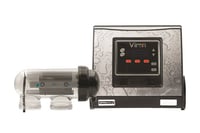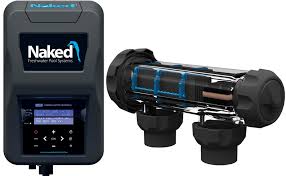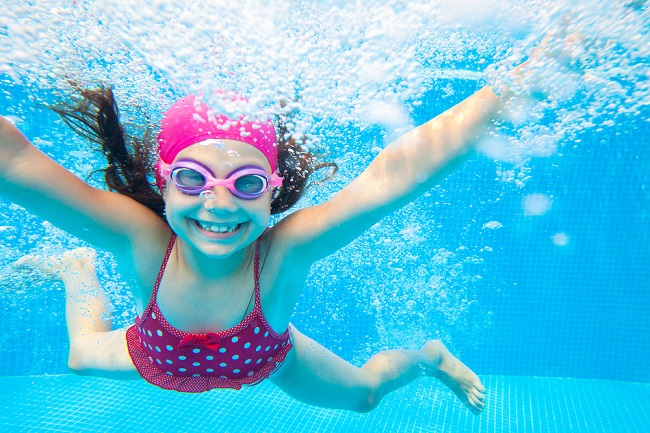What Is The Difference Between Saltwater, Mineral and Freshwater Pools?
"What is the difference between saltwater, mineral and freshwater pools?" If you are unsure, you are not alone! There plenty of claims out there offering "low salt", "salt free" and "chlorine free" options to sanitise your pool with equally big differences in the costs to buy and run the systems over 5 years. Spoiler alert! Many "freshwater pools" have chlorine despite what the box says. Any pool, including DIY fibreglass pool kits, can be salt water, mineral or freshwater. Read on to understand the pro's and con's of each option including costs.
Before we look at the different the options, let’s start with why you need chlorine in your pool water. Chlorine kills the bacteria, algae and other yuckies (highly technical scientific term) that can be in your pool. It's why chlorine is in our tap water and usually in bleach too. It keeps your water sanitised and safe to swim in.
All pools need some form of chlorine or sanitising agent (yes, even the awesome Naked Freshwater System produces a little bit of chlorine). The main difference between the systems is how chlorine is produced and the amount of chlorine in your water.
There are three main systems to chlorinate your pool - manual chlorine, salt water and mineral water.
Chlorine Swimming Pools
Chlorine can be added directly to your pool water as a dissolvable tablet, a liquid or in granular form. If you use to see an adult throwing strong smelling stuff from a bucket into your pool every other day in summer, you had a manually dosed liquid or granular chlorine pool. As it is a manual process, the challenge is maintaining a stable level of chlorine. When a dose is added, chlorine levels peak and then slowly reduce until more is needed. You might remember said parent saying "Don't swim in the pool for an hour, I've just put in chlorine" and then you promptly dived in 10 minutes later to enjoy burning eyes.
throwing strong smelling stuff from a bucket into your pool every other day in summer, you had a manually dosed liquid or granular chlorine pool. As it is a manual process, the challenge is maintaining a stable level of chlorine. When a dose is added, chlorine levels peak and then slowly reduce until more is needed. You might remember said parent saying "Don't swim in the pool for an hour, I've just put in chlorine" and then you promptly dived in 10 minutes later to enjoy burning eyes.
The biggest complaint about manually chlorinated pools is the strong smell, faded bathers/togs/swimmers, skin feeling dry after a swim, and a bit smelly. Swimmers with sensitive eyes or eczema are usually not big fans.
With kids in the pool every day in the warmer months, frequent chlorine testing and dosing is usually needed. As it is a manual system, us Aussie blokes can tend to go with the "I'm not quite sure how much I need to add, so I'll throw in a little extra just to be safe" approach. Perfectly reasonable thinking in my mind until the kids start complaining about too much chlorine in the water!
A quick back to school science thing - as a heads up "chloride" means salt!
Recognising the short comings of manually chlorinating a pool, saltwater chlorinators were invented decades ago. 
Tap water doesn't contain salt (sodium chloride) so you need to manually add pool salt (sodium chloride) into your pool water. Sodium chloride is the same table salt we sprinkle on our food and is in the ocean.
Saltwater chlorinators have a salt cell that uses electrolysis to convert the salt (sodium chloride) in your pool water into chlorine. The salt cell produces a continuous bacteria-killing supply of chlorine while your pool pump is running. It is like being the manager of your own chlorine factory without ever having to touch a bottle or tablet of chlorine. Your pool water will feel softer without the strong chlorine smell as chlorine levels don’t peak and trough like a manually dosed pool. This is why almost all backyard pools bought in the last 20 years are salt water pools.
Pool salt (sodium chloride) is cheap and normally can be bought in 15kg and 20kg bags. You will spend around $100 to $300 on salt per year depending on your pool size and how much water you are topping up each week (meaning if each bombie competition requires a 1,000 litre top up of water, you will use more salt and chemicals maintaining your water sanitisation as you are continually diluting your water). If you are not losing any water each week or your pool water isn't being diluted by rain, you won't need to replace any salt as the process of producing chlorine doesn't "use up" the salt.
Your pool will not taste and feel like ocean water as the salt concentration needed is 95% less than what is in the ocean. Depending on your pool size and whether you are in a warmer state like Queensland or cooler state like Victoria, your unheated pool will generally need between 10 grams and 25 grams of chlorine per hour to meet Australian Standards for water quality. Chlorine is drying on the skin so a swim in a saltwater chlorinated pool can leave some swimmers like jumping in the shower for a rinse off and some hair conditioner.
As saltwater chlorinators are fully automatic you need to keep less of an eye on your chlorine levels compared to a traditional “add the chlorine in manually” pool. We humans can be a little on the lazy side at times which means we are tempted to set and forget. You will still need to check your pool chlorine levels weekly when the pool is in use. Too much chlorine can damage your pool and pool equipment and too little will invite an algae bloom.
The initial purchase price will be between $900 and $1,400 for a basic chlorinator with a low maintenance self cleaning salt cell. The salt cell will generally need to be replaced every 3 to 5 years and will cost between $300 and $600 depending on your brand and model.
Mineral Swimming Pools

The solution to reducing the drying feeling of a salt (sodium chloride) water chlorinated pool is to add potassium and magnesium. Potassium is a natural moisturiser which eliminates feeling like your skin and hair is dry after swimming in a saltwater pool. Potassium is awesome at preventing skin sensitivities like eczema, psoriasis or dermatitis flaring up after a swim.
Magnesium gives your water a soft, silky feel (grab magnesium bath salts and jump into your bath to test drive how it feels). Magnesium is also a bacteria and algae spore killer and acts as a natural sanitiser in your water. Subsequently, a mineral pool requires 40% less chlorine than a saltwater chlorinated pool to stay safe and sanitised.
Us humans absorb around 400ml to 500mls of pool water per hour of swimming until we get water logged (otherwise known universally by kids as "granny hands"). The benefits of magnesium on hair, skin and muscle health are well established and plenty of swimmers prefer to be absorbing minerals rather than chemicals.
Check to make sure the mineral blend you are buying are food grade which ensures you are getting a consistent mineral concentration and quality of minerals without contaminates for your hard-earned money. Minerals from the "Dead Sea" is pretty enticing as it sounds so natural. Being natural is the issue. The quality and amount of potassium and magnesium can vary with every bag as it is naturally produced. Too much magnesium in your pool can lead to crystals forming which can stain your pool (they can be removed). Natural minerals can also contain naturally occurring contaminates like surface staining metals and phosphates (neither belong in your pool!).
Adding magnesium and potassium to your pool often increases water hardness. Quality pool mineral blends will include boron which is a natural water softener and helps offset higher water hardness. If boron is not present, you will need to add a chemical softener to manage your water hardness.
You can mineralise your pool using a standard saltwater chlorinator. Your mineral mix will likely be around 30% salt (sodium chloride), 5% boron and 65% magnesium and potassium (Astral's Aquatherape is mixed to this blend using Australian farmed food grade minerals). The low salt (sodium chloride) content is sufficient for your salt cell to produce the reduced amount of chlorine. This is the lowest cost way to mineralise your pool as you don't need to replace your salt water chlorinator.
Or, you can install a chlorinator that produces chlorine from the potassium present in the water. The most well known is MagnaPool and they call their chlorinator a "hydroxinator". Sounds spaced age fancy however it is a chlorinator with a salt cell. You might read that this makes your pool "salt free". What this really means is sodium chloride (salt) free. Potassium's full name is "potassium chloride" which is another form of salt. The chlorinator works in the same way as a salt cell however converts the potassium (salt) into chlorine instead of sodium chloride.
The main advantage of installing a chlorinator that produces chlorine from potassium is the mineral blend will usually be around 30% magnesium and 70% potassium. Compared to the example Aquatherape blend above, your pool will have a higher concentration of potassium and magnesium without any sodium chloride.
These chlorinators cost between $2,200 and $3,100 to purchase depending on the brand and model. The salt cell will need to be replaced around the 5 year or so mark and will cost between $600 and $800 to replace.
Rather than adding pool salt (sodium chloride) after your pools first fill after installation, you add bags of blended minerals. The cost of the minerals will be between $300 and $1,200 depending on the size of your pool. A rule of thumb is 40kg of minerals per 10,000 litres of water. You will need to top up your mineral levels as you would a salt water pool discussed above. A bag of minerals will be around $40 to $50 (15kg) whereas pool salt will cost around $15 per bag (20kg).
If you already have a salt water pool, you can also easily convert your pool to a mineral pool without having to change your chlorinator.
Freshwater Chlorinated Swimming Pools
You might know these as a copper and silver sanitised, bionised, chlorine free or freshwater pools. They are all talking about the same method of sanitising your water. The promoted advantage of a freshwater pool is no chlorine and very low or no chemicals. Sign me up you say! Let's use some freshwater to cool those jets. There is a lot to like about freshwater systems however there are some drawbacks.
Freshwater chlorinators use Copper and Silver anodes to produce bacteria and algae spore killing ions. Silver ions kill bacteria and Copper ions kill algae spores. Sounds a little Star Trek doesn't it? "Captain, ionise those Klingon spores!" With no chlorine being produced, stabiliser isn't needed and ions are not affected by UV light. Other chemicals like softener are not normally needed and certainly no salt.
ions kill algae spores. Sounds a little Star Trek doesn't it? "Captain, ionise those Klingon spores!" With no chlorine being produced, stabiliser isn't needed and ions are not affected by UV light. Other chemicals like softener are not normally needed and certainly no salt.
Ion's die as soon as they come into contact with bacteria or spores in your water which means they last as long as a sneeze. On days with heavy bather loads (lots of people in your pool), the higher levels of bacteria and contaminants often exceeds the ions being produced. It is not uncommon to have to manually dose the pool with chlorine to sanitise the pool and allow the freshwater system to recover.
Australian Standards requires your pool water to maintain a residual level of sanitising agent when your chlorinator and pump isn't running to keep up the fight against bacteria and algae. With our ion friends having a glorious but short life, freshwater pools don't have a residual reading which means your pool may not be compliant with Australian Standards. The solution is either run your chlorinator and pump 24 hours a day without turning if off or manually add some chlorine. Early versions of these systems also had problems with the Copper ions staining the pool surface in fibreglass and concrete pools leading to some pool manufacturers refusing to install these systems.
Around 10 years ago some clever boffins came up with a hybrid freshwater model that solved both of these issues. By adding a chlorine oxidiser to the Copper and Silver anode system, the hybrid freshwater chlorination system was born. The chlorine oxidiser runs off very, very low levels of salt which produces just enough chlorine to meet the residual chlorine level required by the Australian Standards when the pump is off. How much salt? About 7kg for every 10,000 litres when first setting up which is virtually nothing. How much chlorine? About the same amount that is present in Australian drinking water which is normally very, very low and with no smell. With the addition of chlorine, the volume of Copper ions required is reduced to a level that doesn't stain pool surfaces.
The easiest way to know how a hybrid fresh water pool feels is to have a shower and see how your skins feels once you've towelled off. As you are not adding chemical stabiliser and water softener, your pool water is a very low chemical pool that doesn't have any drying effect that chlorine and salt water chlorinated pools can have. Nice! If you have a media filter, you can discharge your dirty filter water straight onto your lawn or garden bed. Salt water and chlorine pool dirty water needs to discharge directly into a sewer line.
To purchase a hybrid freshwater chlorinator will cost you between $3,600 and $4,200. The anodes generally have a 3 to 5 year life and cost around $400 to replace. The oxidiser isn't cheap at around $1,000 and may need to be replaced around the 5 year mark.
Mineral Pools and Freshwater Pools Are Chemical Free Aren't They?
Let's also clear up a common misunderstanding - there is no getting away from monitoring and testing your pH, water hardness and calcium levels whether you have a saltwater, mineral pool or freshwater pool. This means you will still use pool acid and buffers and potentially water softeners and calcium treatment products.
You will also need to add stabiliser to your salt water pool or mineral pool. Why? UV light from the sun can kill chlorine faster than it can be produced by your chlorinator. The solution is to add a chemical (cyanuric acid) called stabiliser which acts like a sunburn cream for your pool water and stops the untimely death of your chlorine at the hands of the sun.
Summary
There is a good reason why the majority of pools sold in Australia are saltwater chlorinated pools. They are efficient, cost effective to buy and maintain and are liked by the pool buying public for their ease of use. If any regular swimmers in your pool have skin sensitivities like eczema or other muscle related challenges, mineralising your pool is going to make a noticeable difference to your pool fun and how you feel after a swim. If this isn't you, mineralising is pure personal preference and is a good middle ground between salt water and freshwater systems. The hybrid freshwater system is the Rolls Royce option. There is no science to suggest any noticeable health benefits so again, it is pure personal preference for those with the budget to pay the premium to buy and run the system.

Related Blogs
When it comes to backyard swimming pools, fibreglass options often come out on top. They are fast to install, low maintenance, and last for decades. But are they perfect for everyone? Not necessarily.
Thinking about joining the world of fibreglass pools? You might feel like you’ve stumbled into a whole new language of coping, skimmers, gelcoats... What the heck does it all mean?
Thinking about installing your own fibreglass pool in New South Wales? Good on you — done right, DIY pools can save you serious money without cutting quality and still look like a pro job. But....
About The Author
My wife and I grew up playing in swimming pools. Our daughters learnt to swim in our backyard fibreglass swimming pool. There is nothing quite like hearing kids splashing about and giggling. As pools do, our pool became a social magnet for friends, family and neighbours which we loved. Helping customers to have their own pool and saving customers thousands on their pool and equipment is the best job in the world.

























